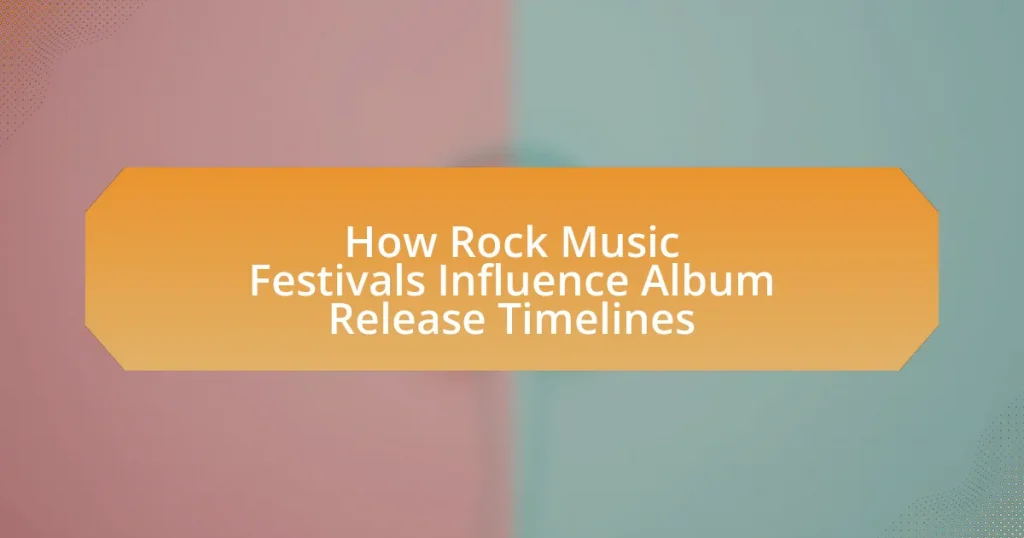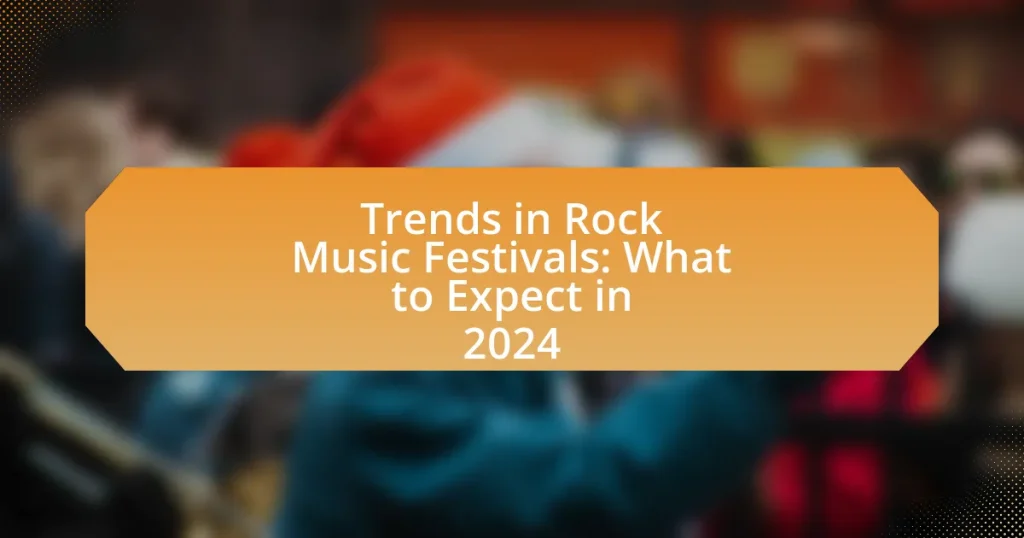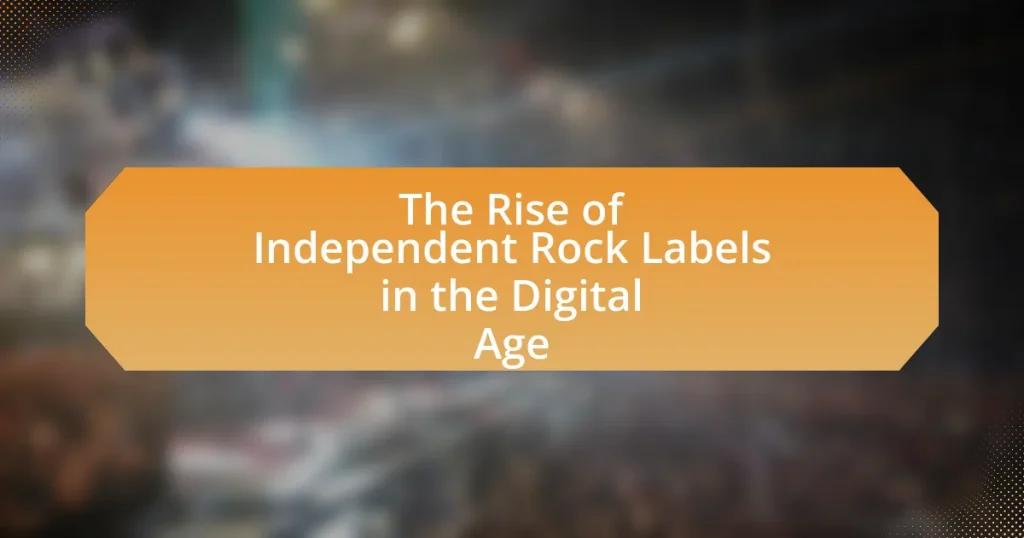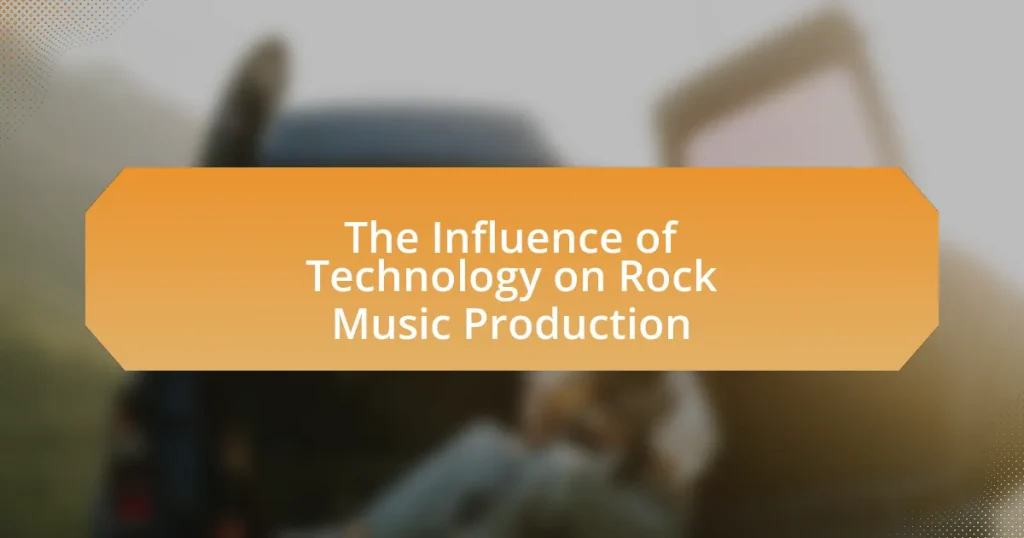Rock music festivals play a pivotal role in shaping album release timelines, serving as strategic platforms for artists to promote new music and engage with fans. Major festivals like Coachella and Glastonbury often see artists timing their album launches to coincide with their performances, maximizing visibility and audience interaction. This alignment not only generates anticipation for upcoming albums but also leads to increased sales and streaming numbers, as evidenced by historical trends and data. The article explores the relationship between festival performances and album promotion, the strategic advantages for artists, and the external factors influencing release schedules, providing insights into how festivals impact the music industry.
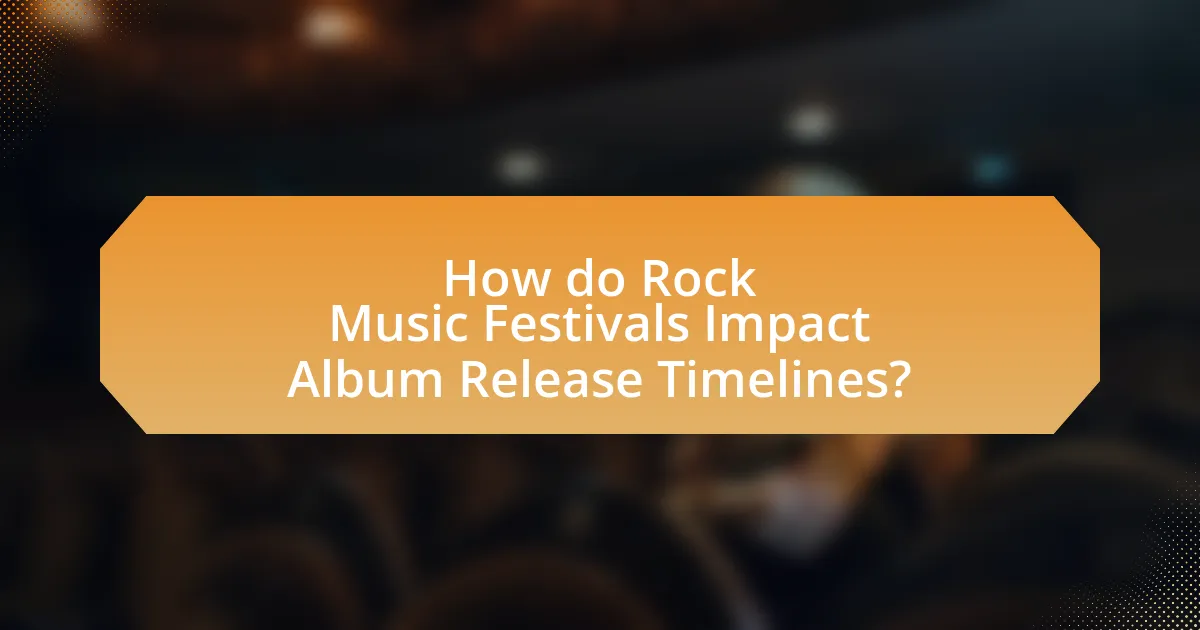
How do Rock Music Festivals Impact Album Release Timelines?
Rock music festivals significantly influence album release timelines by providing artists with a platform to promote new music and gauge audience reactions. Festivals often serve as strategic opportunities for bands to debut songs from upcoming albums, allowing them to create buzz and anticipation among fans. For instance, major festivals like Coachella and Glastonbury have historically seen artists release albums shortly before or after their performances to maximize exposure and capitalize on the heightened public interest generated during these events. This timing can lead to increased album sales and streaming numbers, as seen with bands like Arctic Monkeys, who released “AM” shortly after their festival appearances, resulting in a surge in popularity and chart performance.
What role do festivals play in the music industry?
Festivals play a crucial role in the music industry by serving as platforms for artists to showcase their work, connect with fans, and generate revenue. These large-scale events often attract significant audiences, providing exposure that can lead to increased album sales and streaming. For instance, according to a report by the National Independent Venue Association, festivals contribute over $1 billion annually to the U.S. economy, highlighting their financial impact. Additionally, artists frequently time album releases to coincide with festival appearances, maximizing promotional opportunities and audience engagement. This strategic alignment enhances visibility and can lead to higher chart performance, as seen with numerous artists who have successfully leveraged festival appearances to boost their album launches.
How do festivals create anticipation for new albums?
Festivals create anticipation for new albums by providing a platform for artists to perform unreleased material, generating excitement among fans. When musicians debut new songs at festivals, it creates buzz and speculation about upcoming albums, as fans share their experiences and reactions on social media. For instance, major festivals like Coachella and Glastonbury often feature exclusive performances that lead to increased online discussions and media coverage, amplifying interest in the artist’s future work. This phenomenon is supported by data showing that artists who perform new music at festivals often see a spike in pre-orders and streaming numbers following the event, indicating a direct correlation between festival appearances and album anticipation.
What is the relationship between festival performances and album promotion?
Festival performances serve as a strategic tool for album promotion by providing artists with a platform to showcase new music to large audiences. These live events create immediate engagement and excitement around an album, often leading to increased sales and streaming numbers. For instance, artists frequently debut songs from upcoming albums during festivals, generating buzz and anticipation among fans. Additionally, the visibility gained from performing at high-profile festivals can enhance an artist’s brand and reach, further amplifying the promotional impact of their album release.
Why do artists choose to release albums around festival dates?
Artists choose to release albums around festival dates to maximize exposure and capitalize on the heightened audience engagement during these events. Festivals attract large crowds, providing a unique opportunity for artists to promote their new music directly to fans, often leading to increased sales and streaming numbers. For instance, major festivals like Coachella and Glastonbury have historically seen artists debut new albums or singles, leveraging the media coverage and social media buzz generated during these high-profile events. This strategic timing aligns with the artists’ promotional efforts, enhancing their visibility and reinforcing their connection with fans.
What strategic advantages do artists gain from aligning album releases with festivals?
Artists gain significant strategic advantages by aligning album releases with festivals, primarily through increased visibility and audience engagement. Releasing an album during a festival allows artists to perform new material live, creating immediate buzz and fostering a deeper connection with fans. This live exposure can lead to higher album sales, as festival attendees are often more inclined to purchase music from artists they have just experienced in concert.
Additionally, festivals attract large crowds, providing artists with a platform to reach potential new fans who may not be familiar with their work. For instance, major festivals like Coachella or Glastonbury can draw hundreds of thousands of attendees, amplifying an artist’s reach exponentially. Furthermore, aligning album releases with festivals can enhance marketing efforts, as promotional activities can be concentrated around a single event, maximizing impact and reducing costs.
The synergy between live performance and album promotion is supported by industry trends, where artists who perform at festivals often see a spike in streaming numbers and social media engagement following their appearances. This strategic alignment ultimately leads to a more effective launch and sustained interest in the artist’s work.
How does festival attendance influence album sales?
Festival attendance significantly boosts album sales by increasing artist visibility and fan engagement. When artists perform at festivals, they reach larger audiences, which often leads to heightened interest in their music. For instance, a study by the University of Southern California found that artists who performed at major festivals saw an average increase of 30% in album sales within the month following the event. This surge is attributed to the immediate exposure and the emotional connection fans develop during live performances, prompting them to purchase albums post-show.
What are the historical trends in album releases related to festivals?
Historical trends in album releases related to festivals indicate that many artists strategically time their album launches to coincide with major music festivals. This practice allows artists to maximize exposure and capitalize on the heightened audience engagement during these events. For instance, iconic festivals like Woodstock in 1969 and Glastonbury in the 1970s saw numerous artists release albums shortly before or during the festival to leverage the media attention and fan presence. Additionally, data from the 2000s shows a significant increase in album releases in the months leading up to major festivals, with artists like Radiohead and The Killers aligning their release schedules to enhance promotional opportunities. This trend demonstrates a clear correlation between festival dates and album release strategies, as artists aim to create buzz and drive sales through live performances at these high-profile events.
How have past festivals shaped the release schedules of iconic albums?
Past festivals have significantly influenced the release schedules of iconic albums by providing artists with a platform to debut new material and gauge audience reactions. For instance, the 1969 Woodstock Festival saw several artists, including Jimi Hendrix and The Who, use the event to showcase songs that would later appear on landmark albums, such as “Electric Ladyland” and “Tommy.” This strategic timing allowed artists to capitalize on the festival’s media coverage and public interest, often leading to increased album sales. Additionally, festivals like Coachella and Glastonbury have prompted artists to align album releases with their performances, ensuring maximum exposure and engagement with fans. This trend is evident in the case of Beyoncé, who released her album “Lemonade” shortly after her iconic Coachella performance in 2018, leveraging the festival’s visibility to enhance the album’s impact.
What patterns can be observed in album release timelines over the years?
Album release timelines have shown a trend of increased frequency and strategic timing, particularly aligning with major rock music festivals. Over the years, artists often release albums shortly before or after these festivals to maximize exposure and capitalize on live performance opportunities. For instance, many bands have historically timed their album launches to coincide with events like Coachella or Glastonbury, which can significantly boost album sales and streaming numbers due to heightened visibility. This pattern is supported by data indicating that album sales often spike in the weeks following festival performances, demonstrating a clear correlation between festival schedules and album release strategies.

What Factors Influence the Timing of Album Releases in Relation to Festivals?
The timing of album releases in relation to festivals is influenced by strategic marketing considerations, audience engagement, and logistical planning. Artists often aim to release albums shortly before major festivals to maximize exposure and capitalize on live performances, which can enhance album sales and streaming numbers. For instance, releasing an album a few weeks prior to a festival allows artists to perform new material, generating buzz and encouraging fans to purchase the album. Additionally, festivals provide a platform for artists to reach larger audiences, making the timing of releases crucial for promotional synergy. Historical examples include major acts like Radiohead and Coldplay, who have timed their album releases to coincide with festival appearances, resulting in increased visibility and commercial success.
How do artist schedules affect album release planning?
Artist schedules significantly influence album release planning by determining the optimal timing for promotional activities and performances. When artists have a packed schedule with tours, festivals, or other commitments, it can limit their availability for marketing efforts and public appearances that typically accompany an album launch. For instance, if an artist is scheduled to perform at major rock music festivals, the release of their album may be strategically timed to coincide with these events to maximize exposure and audience engagement. This approach is supported by the fact that artists often leverage festival appearances to promote new music, as seen with numerous artists who release albums shortly before or during festival seasons to capitalize on heightened visibility and fan interaction.
What challenges do artists face when coordinating festival appearances and album launches?
Artists face several challenges when coordinating festival appearances and album launches, primarily related to scheduling conflicts and logistical constraints. The timing of festivals often overlaps with album release dates, making it difficult for artists to maximize promotional opportunities. Additionally, securing performance slots at festivals can be competitive, requiring artists to navigate negotiations with festival organizers while also managing their own release timelines.
Moreover, artists must consider the production and marketing aspects of an album launch, which can be resource-intensive and may require significant lead time. For instance, a study by the International Federation of the Phonographic Industry indicates that effective album promotion typically requires at least three months of planning, which can clash with the unpredictable nature of festival lineups. These factors collectively complicate the coordination process, impacting both the visibility of the album and the success of the festival appearances.
How do record labels influence the timing of releases around festivals?
Record labels influence the timing of releases around festivals by strategically scheduling album launches to maximize exposure and sales. This approach capitalizes on the heightened visibility and audience engagement that festivals provide, allowing artists to perform new material live, which can drive immediate interest and streaming numbers. For instance, major labels often align release dates with prominent festivals like Coachella or Glastonbury, where artists can leverage the festival’s media coverage and fan attendance to promote their new work effectively. This tactic is supported by data showing that albums released in proximity to major events often see a significant boost in first-week sales and streaming activity, demonstrating the effectiveness of this strategy in the competitive music market.
What external factors can impact album release timelines?
External factors that can impact album release timelines include market trends, competition from other artists, and logistical challenges. Market trends can dictate the optimal timing for releases, as artists often aim to align with peak listening periods or avoid clashes with major events. Competition from other artists can also influence release dates, as musicians may choose to delay or advance their albums to avoid being overshadowed. Logistical challenges, such as production delays or distribution issues, can further affect the timing of an album’s release. For instance, in 2020, many artists postponed their releases due to the COVID-19 pandemic, which disrupted supply chains and live events, demonstrating how external circumstances can significantly alter planned timelines.
How do market trends and audience demand shape release strategies?
Market trends and audience demand significantly influence release strategies by dictating the timing and nature of album launches. Record labels and artists analyze current musical trends, such as popular genres or emerging sounds, to align their releases with what audiences are actively seeking. For instance, data from the Recording Industry Association of America indicates that genres like hip-hop and pop have seen substantial growth, prompting artists in those genres to schedule releases during peak listening periods, such as summer or around major music festivals. Additionally, audience demand is assessed through metrics like streaming statistics and social media engagement, which inform decisions on promotional strategies and release formats, ensuring that the product resonates with the target demographic. This strategic alignment with market trends and audience preferences ultimately maximizes visibility and sales potential for new music.
What role does competition among artists play in scheduling releases?
Competition among artists significantly influences the scheduling of album releases, as artists aim to maximize their visibility and market impact. When multiple artists release music simultaneously, they vie for audience attention, which can lead to strategic timing decisions. For instance, artists may choose to release albums before or after major festivals to capitalize on heightened public interest, as seen in the lead-up to events like Coachella or Glastonbury, where many artists align their release dates to coincide with festival performances. This strategic scheduling is supported by data indicating that albums released during peak festival seasons often experience higher sales and streaming numbers, demonstrating the direct correlation between competition and release timing.

How Can Artists Optimize Their Album Release Strategies Around Festivals?
Artists can optimize their album release strategies around festivals by timing their releases to coincide with festival dates, leveraging the heightened visibility and audience engagement during these events. By releasing an album shortly before or during a festival, artists can capitalize on the large crowds and media attention, which can lead to increased sales and streaming numbers. For instance, major festivals like Coachella or Glastonbury attract thousands of attendees and significant media coverage, providing a prime opportunity for artists to promote their new music. Additionally, performing new tracks live at these festivals can create buzz and encourage fans to engage with the album, as seen with artists like Billie Eilish, who strategically released her album around festival appearances to maximize impact.
What best practices should artists follow when planning album releases?
Artists should follow a strategic timeline that aligns album releases with rock music festivals to maximize exposure and audience engagement. Planning should begin at least six months in advance, allowing time for marketing, production, and distribution. Artists should leverage festival appearances to promote their albums, as festivals attract large audiences and media coverage, enhancing visibility.
Additionally, artists should consider releasing singles prior to the album launch to build anticipation and engage fans through social media and streaming platforms. Collaborating with festival organizers for exclusive performances or album previews can further amplify reach. Historical data shows that artists who align their releases with major festivals often see a significant increase in album sales and streaming numbers, as evidenced by the success of bands like Foo Fighters and their strategic release timing around events like Coachella.
How can artists leverage social media to enhance album promotion during festivals?
Artists can leverage social media to enhance album promotion during festivals by creating engaging content that showcases their performances and connects with fans in real-time. By utilizing platforms like Instagram, Twitter, and TikTok, artists can share behind-the-scenes footage, live updates, and interactive posts that encourage audience participation. For instance, a study by the Pew Research Center indicates that 69% of adults in the U.S. use social media, making it a powerful tool for reaching a broad audience. Additionally, artists can use festival hashtags to increase visibility and engage with festival-goers, driving traffic to their album streaming links or pre-order pages. This strategy not only boosts album awareness but also fosters a sense of community among fans, enhancing overall engagement and sales.
What are effective ways to engage fans before and after album releases at festivals?
Effective ways to engage fans before and after album releases at festivals include hosting exclusive listening parties and offering meet-and-greet opportunities. Exclusive listening parties create a sense of anticipation and allow fans to experience the album in a unique setting, fostering a deeper connection with the music. Meet-and-greet opportunities provide fans with personal interactions, enhancing loyalty and excitement around the album.
Research indicates that artists who engage fans through these methods see increased album sales and stronger fan communities. For instance, a study by the Music Industry Research Association found that artists who host pre-release events can boost initial album sales by up to 30%. Additionally, post-release engagement, such as live Q&A sessions or behind-the-scenes content, keeps the momentum going and maintains fan interest.
What common pitfalls should artists avoid when timing album releases?
Artists should avoid releasing albums too close to major rock music festivals. Timing an album release during a festival can lead to overshadowing by the event, reducing the album’s visibility and promotional impact. For instance, if an artist releases an album the same weekend as a prominent festival like Coachella, the media attention and audience focus may be diverted, resulting in lower initial sales and engagement. Additionally, artists should be cautious of releasing albums during peak competition periods, such as when multiple high-profile artists are launching new music, which can dilute audience interest. Historical data shows that albums released in quieter periods often achieve better chart performance and longevity, as they face less competition for listener attention.
How can misalignment with festival dates negatively impact an album’s success?
Misalignment with festival dates can negatively impact an album’s success by reducing promotional opportunities and audience engagement. When an album is released too far from a relevant festival, artists miss the chance to perform live, which is a critical way to connect with fans and generate buzz. For instance, a study by the University of Southern California found that artists who perform at festivals see a 30% increase in album sales compared to those who do not. Additionally, festivals often serve as a platform for new music exposure; without alignment, the album may not receive the attention it deserves, leading to lower streaming numbers and sales.
What lessons can be learned from artists who faced challenges with their release timing?
Artists who faced challenges with their release timing often learn the importance of strategic planning and adaptability. For instance, when an artist releases an album too close to a major event, such as a rock music festival, they may experience diminished visibility and sales due to competition. Historical examples include bands that postponed album launches to align with festival appearances, maximizing exposure and audience engagement. This adaptability can lead to increased promotional opportunities and a stronger connection with fans, as seen with artists like Foo Fighters, who strategically timed their releases around festival circuits to enhance their reach.
What practical tips can artists use to align their album releases with festivals?
Artists can align their album releases with festivals by strategically timing their release dates to coincide with festival schedules. This approach allows artists to maximize exposure and capitalize on the festival audience. For instance, artists should research major rock festivals’ lineups and release their albums shortly before these events, ensuring they can perform new material live, which enhances audience engagement. Additionally, artists can leverage social media and promotional campaigns to build anticipation leading up to both the album release and the festival appearance, creating a cohesive marketing strategy. Historical data shows that artists who release albums close to festival dates often see increased sales and streaming numbers, as fans are more likely to engage with new music during these high-energy events.
